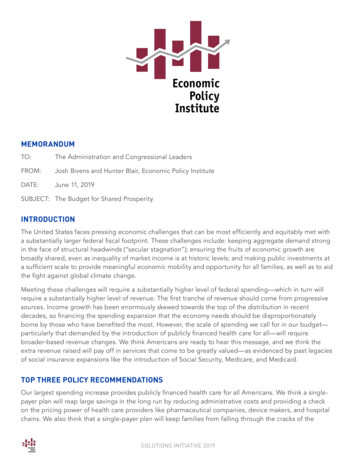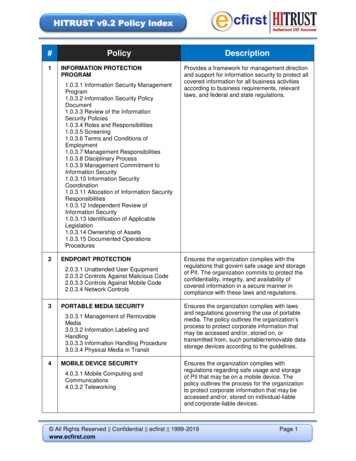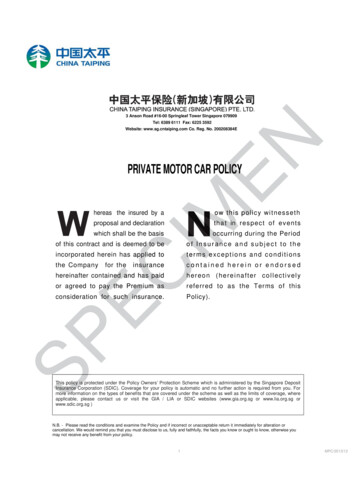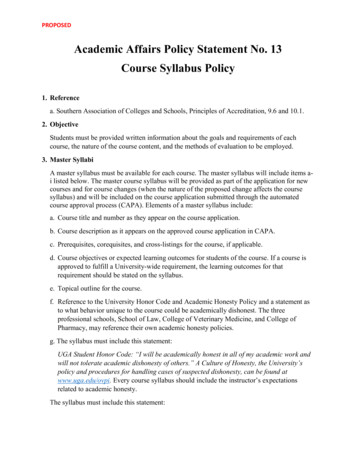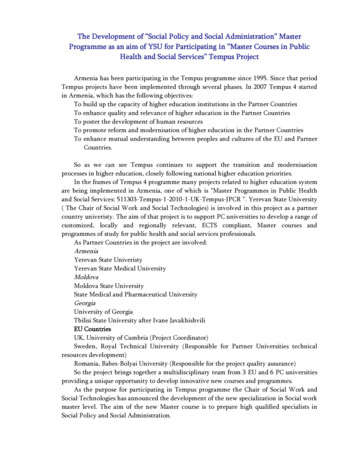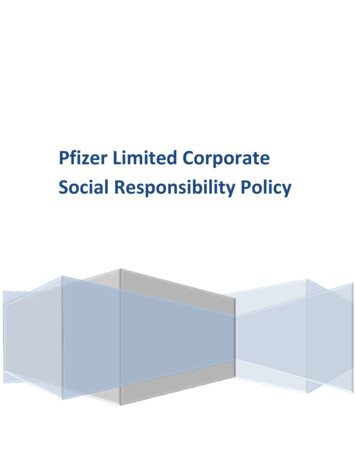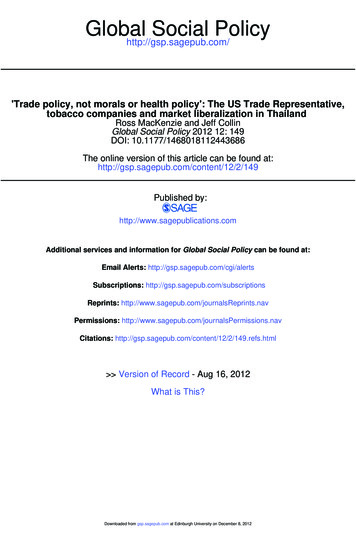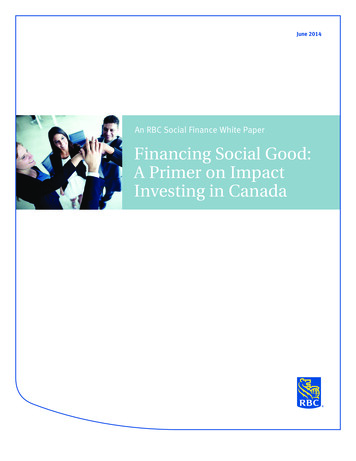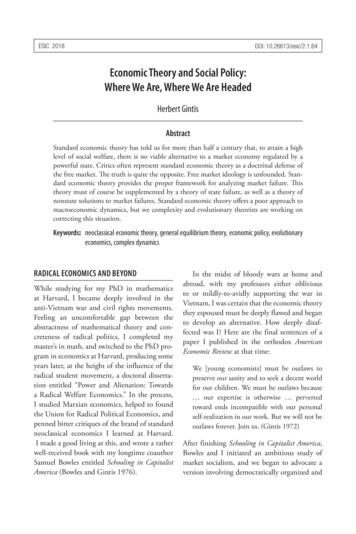
Transcription
ESIC 2018DOI: 10.26613/esic/2.1.64Economic Theory and Social Policy:Where We Are, Where We Are HeadedHerbert GintisAbstractStandard economic theory has told us for more than half a century that, to attain a highlevel of social welfare, there is no viable alternative to a market economy regulated by apowerful state. Critics often represent standard economic theory as a doctrinal defense ofthe free market. The truth is quite the opposite. Free market ideology is unfounded. Standard economic theory provides the proper framework for analyzing market failure. Thistheory must of course be supplemented by a theory of state failure, as well as a theory ofnonstate solutions to market failures. Standard economic theory offers a poor approach tomacroeconomic dynamics, but we complexity and evolutionary theorists are working oncorrecting this situation.Keywords: n eoclassical economic theory, general equilibrium theory, economic policy, evolutionaryeconomics, complex dynamicsRADICAL ECONOMICS AND BEYONDWhile studying for my PhD in mathematicsat Harvard, I became deeply involved in theanti-Vietnam war and civil rights movements.Feeling an uncomfortable gap between theabstractness of mathematical theory and concreteness of radical politics, I completed mymaster’s in math, and switched to the PhD program in economics at Harvard, producing someyears later, at the height of the influence of theradical student movement, a doctoral dissertation entitled “Power and Alienation: Towardsa Radical Welfare Economics.” In the process,I studied Marxian economics, helped to foundthe Union for Radical Political Economics, andpenned bitter critiques of the brand of standardneoclassical economics I learned at Harvard.I made a good living at this, and wrote a ratherwell-received book with my longtime coauthorSamuel Bowles entitled Schooling in CapitalistAmerica (Bowles and Gintis 1976).In the midst of bloody wars at home andabroad, with my professors either obliviousto or mildly-to-avidly supporting the war inVietnam, I was certain that the economic theorythey espoused must be deeply flawed and beganto develop an alternative. How deeply disaffected was I? Here are the final sentences of apaper I published in the orthodox AmericanEconomic Review at that time:We [young economists] must be outlaws topreserve our sanity and to seek a decent worldfor our children. We must be outlaws because our expertise is otherwise pervertedtoward ends incompatible with our personalself-realization in our work. But we will not beoutlaws forever. Join us. (Gintis 1972)After finishing Schooling in Capitalist America,Bowles and I initiated an ambitious study ofmarket socialism, and we began to advocate aversion involving democratically organized and
Herbert Gintisworker-controlled firms (Bowles and Gintis1990, 1996). But there was a problem withour theory that resisted solution: if workercontrolled firms would be at least as efficient ascapitalist-controlled firms, why did such firmsnot simply win out on competitive markets?One could offer silly reasons, such as collusionamong capitalists to undermine democraticworkplaces or laws that disfavor economicdemocracy. But we considered such explanations as implausible at best. We concluded, onthe basis of standard economic reasoning, thatsuch firms cannot enjoy the benefits of widelydispersed ownership characteristic of large capitalist firms (Gintis 1989).This experience guided me to three rathermomentous conclusions. First, the marketsocialist economy based on worker control is nomore feasible than the state socialist economy asan alternative to capitalism. Therefore we mustembrace capitalism and search for correctivesthat provide social justice with high efficiency.Second, standard economic theory, despite itsflaws, is often powerfully insightful. We shouldthus embrace this theory, dynamicize it, andcorrect its flaws. Third and finally, Marxism isa great way to develop a broad, dynamic, interdisciplinary view of social theory, but it is quiteout of its depth as a serious economic theory. Weshould look elsewhere (especially to complexityand evolution) for inspirational new directionsin economic dynamics. I have thus spent therest of my professional life trying to build on thesuccess and correct the flaws of standard neoclassical economic theory using insights fromthe other behavioral disciplines and deployingthe tools of complexity analysis.Most of my radical economist friends didnot follow this path, arguing that standardeconomic theory is simply an apology for freemarket capitalism. This view is wrong for tworeasons. First, as I shall describe below, standard public economics, fully integrated intostandard economic theory, provides a powerful taxonomy of market failure, one that is ascogent today as when I learned it in graduate2school many years ago. This theory implies thata successful economy will never be a free marketeconomy, but rather will exhibit a high degreeof social regulation to neutralize the effects ofmarket failures. Second, the standard generalequilibrium model in fact provides as strongsupport for the viability of a state socialist economy of the Soviet type as it does for a capitalisteconomy (Lange and Taylor 1938; Schumpeter1942; Gintis 1991). Therefore the economist’s chief model of economic exchange hasno sociopolitical bias whatever. Unfortunately,the standard informational assumptions of thismodel—especially the assumption that a stateplanner has complete information concerningall production processes, technological alternatives, and consumer and worker preferences—are implausible (Hayek 1945; Gintis 1991).This undermines its support for state socialism,but not for a socially regulated market economy.COMBATTING ECONOMIC ILLITERACYProgressives and conservatives alike tend tocharacterize standard economic theory as ajustification of free markets. Conservatives likethe idea, and progressives do not. Thereforethere is a strong tendency in progressive circlessimply to reject standard economic theory andto embrace one or another “heterodox” alternative. Both groups are misinformed, to the pointof being economically illiterate concerning thereceived wisdom of economic theory.It may seem that there is no politically neutralreceived wisdom that is shared by most economists, but this is not the case. Except in the areaof macroeconomic policy, there are few disagreements. In the macroeconomic area, as I describebelow, the standard models are pretty awful. Buteconomic policy has a deeper problem: simplemodels can show you the general direction ofeffects, but when there are offsetting tendencies,only quantitative evidence can supply a credible answer. For instance, increasing governmentexpenditure to lower the unemployment ratemay be offset by the effects of government debtEvolutionary Studies in Imaginative Culture
Economic Theory and Social Policy: Where We Are, Where We Are Headedon interest, inflation, and growth rates. Onlycareful attention to details can determine thenet effect of the policy, and even this is subjectto significant error.However, one cannot even begin to assesseconomic policy seriously unless one knowsbasic economic theory. The books mentionedbelow are basic starting points for gaining afacility in economic theory. Alternatively, youcan simply buy one of the leading undergraduate textbooks and plow through it. The textbookwill be more demanding, very fat, and quiteexpensive. Before doing this, I advise that youtackle one or more of the following volumes.They are all quite good, and it wouldn’t hurtto read them all. But here are my impressions. harles Wheelan, Naked Economics: UndressingCthe Dismal Science (W. W. Norton, 2010)Wheelan explains the benefits and limitationsof markets, the benefits and limitations of government interventions, the basics of finance(especially, how to avoid the costly errors thatabout 50% of investors are prone to make,such as believing they can pick winners), andthe role of international competition. Thereis nothing that Wheelan asserts that I thinkis not 100% correct, including his expositionof development economics and globalization.Highly recommended. Sean Flynn, Economics for Dummies (Wiley,2011)This book is the most sophisticated of the threeand covers extremely important material leftout of the others. This includes an analysis ofproperty rights, market externalities, publicgoods, asymmetric information, and otherabsolutely fundamental aspects of modern economic theory, which is really the theory of theinteraction between markets and governmentregulation for efficiency and stability. It is ratherweak on national income accounting (none ofthe books is strong in this very difficult area),and it does no general equilibrium a nalysis (e.g.,the very instructive Edgeworth box is missing).ESIC Vol. 2 No. 1 Spring 2018Finally, the book rather slights statistical information on the economy and gives littlehistorical perspective. Tom Gorman, The Complete Idiot’s Guide toEconomics (Penguin, 2003)This book is a little out of date, and is especiallyconcerned with regulatory policy in dealingwith market volatility (the business cycle).It has lots of interesting statistics, and gives adetailed explanation of the Federal Reserve andits operation. It is similarly strong on analyzinginternational trade and exchange rates. Readthis after Economics for Dummies. Steve Slavin, Economics: A Self-TeachingGuide (Wiley, 1999)This book does not deal with recent economicissues, but it is well worth reading. It is e speciallystrong on economic history and it presents insome detail the various schools of thought inmacroeconomic theory. It also does considerable national income accounting, which I consider a prerequisite to understanding currenteconomic issues. Its microeconomics sectionsare rather brief. It is certainly not a substitutefor Economics for Dummies.After this, I would tackle the more formal freeonline CORE course on introductory economics at http://www.core-econ.org, developed bymy coauthor Sam Bowles and other colleagues.PROBLEM AREAS OF STANDARD ECONOMICSThere are two problem areas with the standardneoclassical model, which I will identify herewith the Walrasian general market interactionmodel, as described below. The first is that themodel is good at equilibrium analysis, but hasno serious treatment of economic dynamics.In fact, as I explore in my most recent book,Individuality and Entanglement (Gintis 2016b),the absence of plausible dynamic models of theevolution of the economy is evident in sociology and political science as much as in economics. There is some hope that the maturation of3
Herbert Gintiscomplexity theory and evolutionary economicsmight correct this situation.The second problem area is in the modeling of human decision-making. The standardrational actor is very powerful in principle, butit rests on four untenable assumptions. First, ittends to assume that economic actors are selfinterested, whereas, in fact, actors often satisfyall the axioms for rational choice, but they careabout others and use moral reasoning in makingdecisions. Second, the standard rational actormodel assumes agents are consequentialist in thesense of valuing alternatives only according tothe way their choices promote their preferredoutcomes. In fact, in many characteristicallyhuman collective actions, such as voting in alarge election or participating in a mass demonstration, no single individual (except for a fewleaders) makes any difference at all. Yet this participatory behavior exhibits the major characteristics of truly rational behavior (Gintis 2016a).Third, the standard theory takes beliefs as subjective (the agent’s so-called subjective prior),whereas in fact beliefs tend to be distributed andvalidated across social networks. For instance,the often excessive certainty with which individuals profess their beliefs likely derives from thefact that virtually all individuals in their socialnetworks share these beliefs. Contemporarybehavioral and experimental game theoriesprovide powerful tools for repairing these weaknesses of the standard rational actor model.THE GENERAL MARKET INTERACTION MODELWalras (1874) developed a general model ofcompetitive market exchange. In the 1950sseveral researchers contributed to showingthat a market-clearing equilibrium for Walras’smodel exists under quite general conditions(Arrow and Debreu 1954). We call this thegeneral equilibrium model of the market economy. I think the term general market interactionmodel is more appropriate, however, because, asI explain below, it is just as relevant to marketdynamics as to market equilibrium.4In this model, the economy consists of individuals and firms. Firms make products usinglabor, capital goods (buildings, machines), andproducts (called intermediate goods) that theybuy from other firms. Individuals own laborand capital goods, which they supply to firms inreturn for a wage (labor) and a rental price (capital goods). It would be more realistic to havethe firms own their capital goods and simplyborrow money to pay for them from individuals(e.g., through financial markets, such as stocksand bonds). But it amounts to the same thingas simply assuming capital goods, like labor, canbe costlessly moved from one firm to another,and the capital goods are owned by individuals and rented to firms. Of course, when we getto market dynamics, ignoring fixed capital canbe treacherous, but we will deal with dynamicslater. Finally, individuals own shares entitlingthem to the profits generated by the firms.Firms produce marketable goods, which theysell to individuals and to other firms. Individualsconsume whatever they purchase from firms,and whatever funds that remain are used to buycapital goods and shares in the firms, which istheir wealth. If individuals are short of income,they can sell some of their capital goods to otherindividuals. This is often called the double circular flow of goods and money: (1) individualssupply labor and capital to firms, and (2) firmssupply income to households for consumption.The economy is in market equilibrium whenthe wage and rental price of capital goods (interest rates, profit rates) and the prices of goodsequate supply and demand in the labor market,the capital market, and all goods markets, assuming firms maximize profits and individuals maximize their utility over consumption and savings.The general market equilibrium modelis attractive because it abstracts from details,allowing us to state and understand clearly thenature of market failures and evaluate possiblemeasures to correct them at the highest level ofgenerality. In many cases, adding more detailwould not add much, if anything, to the analysis. When it would be useful, we may simplyEvolutionary Studies in Imaginative Culture
Economic Theory and Social Policy: Where We Are, Where We Are Headedadd in more detail. We may thus use this modelto state what are called the “fundamental theorems of welfare economics.”The Fundamental Theorems of Welfare EconomicsTo state the famous First Fundamental Theoremof Welfare Economics, we say an allocation oflabor and capital to firms and goods to individualsis Pareto optimal if any reallocation that makes oneindividual better off must make at least one otherindividual worse off. This is, of course, the standard definition of efficiency in economic theory.We then have, under very general conditions,Theorem 1. First Theorem of WelfareEconomics: Every market equilibrium is Paretooptimal.The proof of this theorem is extremely simple,but not worth going through here. The interested reader can find a proof on Wikipedia.By the way, and to avoid confusion, the term“welfare” in economics does not mean subsidiesto the poor, but rather individual and socialwell-being in general.Theorem 2. Second Fundamental WelfareEconomics: Every Pareto-optimum can beachieved by an initial distribution of ownership oflabor and capital, followed by market exchange.This theorem is interesting, but is of no practical use because it is not politically or ethicallyfeasible to redistribute ownership arbitrarilyto attain equity goals. Moreover, a onetime egalitarian redistribution would likelyreturn to another inegalitarian state in subsequent periods. Of course, continual arbitrary redistributions are possible (if neither ethicalnor politically feasible), but these interferewith incentives and so lead to severe economicinefficiencies.The First Fundamental Theorem, by contrast, is extremely important not because it accurately reflects actual economic conditions, butbecause it helps to understand when it does not,and why. The general market interaction modelESIC Vol. 2 No. 1 Spring 2018is practically relevant because the e conomy isnormally rather close to equilibrium, althoughit can experience rather dramatic excursionsfar from equilibrium for some number of timeperiods, as in the case of f inancial bubbles andpersistent stagnation.THE THEORY OF MARKET FAILUREThe basic question of when unregulated marketsof the sort described above are the most effective instruments of economic efficiency wasworked out in the post–World War II period,and remains valid today, a half century later(Musgrave 1959, Atkinson and Stiglitz 1980).This theory is called the theory of market failure.There are four types of market failure:1. Increasing Returns to Scale. In some production sectors, the efficient firm size is solarge that either efficiency or market competition must be sacrificed. For instance, a city’swater supply may be most efficiently suppliedusing one large reservoir and a unified systemof delivery and waste removal. There is simplyno room for multiple firms to compete, so theservice is supplied by the local government.The problem can sometimes be handledalternatively by requiring firms to share theresource that accounts for increasing returns,such as railroad tracks or an electric grid.2. Public Goods. Some goods are nonexclusionary—they are consumed equally by many or allindividuals, although they may be valued differently by different individuals. For instance,national defense protects all equally, and manyforms of public health measures affect theincidence of diseases for the entire population.Public goods must be publicly provided, or atleast publicly financed, in most cases.3. Market Externalities. Some goods are produced using technologies that release wasteproducts into the environment at zero orlow cost to the producer but that imposehigh costs on everyone else. Economictheory suggests that the costs imposed by5
Herbert Gintisthese effluents be charged to producers,an example being tradeable effluent taxes(Atkinson and Stiglitz 1980).4. Quality Goods. There are many market sectors in which the quality of a product cannotbe ascertained until after purchase, and inwhich reputation effects are not sufficientto ensure a minimum quality level. In suchsectors, quality can be maintained by legalregulation. For instance, most countries havehealth standards for restaurants and qualitystandards for hotels that prevent an upstartfrom profiting at the expense of consumersand the high-quality firms. Similarly, professionals may be licensed (e.g., medical and legalservices), and pharmaceuticals may be regulated for safety and effectiveness. Of course,licensing can also be imposed to give a specialgroup an unmerited monopoly position. Thissuccessful rent-seeking is form of state failure,to which I turn.It is not feasible to correct all market failuresthrough government intervention because regulation may be excessively costly or susceptibleto manipulation by powerful special interestgroups. State failure is quite as endemic as marketfailure. That is, the political dynamics that giverise to particular forms of state intervention aregoverned by forces that may place little valueon public welfare. Special interest groups, forinstance, may agitate for interventions that benefit their members at the expense of the public.Similarly, some forms of regulation invite corruption by officials. These behaviors are knownas rent-seeking in the economics literature(Buchanan, Tollison, and Tullock 1980).GENERAL MARKET INTERACTION THEORY’SCRIPPLED DYNAMICSWalras was aware that his model required aprice-adjustment mechanism that would ensurestability of equilibrium. He considered the keyforce leading to equilibrium to be market competition, which he thought would result in the6continual updating of prices by traders untilequilibrium was attained. However, he believedthat a model where economic agents individually update their prices would be analytically intractable, whereas a simple centralizedmodel of price adjustment, which he called thetâtonnement process (tâtonnement means “groping around” in French), would more easily lenditself to a proof of the stability of equilibrium.Walras modeled the tâtonnement processon the Paris Bourse (stock exchange), wherean auctioneer calls out prices to a multitude ofbuyers and sellers, and sets the final price as thatwhich equates the number of buyers and thenumber of sellers. As it turns out, Walras wasquite mistaken in thinking that such a mechanism leads to dynamic stability.The stability of the Walrasian economybecame a central research focus much later,in the years after the proof of the existence ofequilibrium prices (Arrow and Debreu 1954).Following Walras’s tâtonnement process, thesemodels assumed that there is no production ortrade until equilibrium prices are attained, and,out of equilibrium, there is a price profile sharedby all agents, with the time rate of change ofprices being a function of excess demand.These efforts at proving stability wereunsuccessful (Fisher 1983). Indeed, subsequentanalysis showed that chaotic price movements arethe generic case for the tâtonnement adjustmentprocesses (Saari 1985).COMPLEXITY AND EVOLUTION PROVIDE AMARKET DYNAMICA novel approach to the dynamics of large-scalesocial systems, called “evolutionary gametheory,” was initiated by biologists MaynardSmith and Price (1973), and adapted to dynamical systems theory in subsequent years (Taylorand Jonker 1978; Weibull 1995; Gintis 2009).The application of these models to economicsinvolved the shift from biological reproductionto behavioral imitation, otherwise known as“adaptive dynamics” as the mechanism for theEvolutionary Studies in Imaginative Culture
Economic Theory and Social Policy: Where We Are, Where We Are Headedreplication of successful agents (Mandel andGintis 2014, 2016).I do not have the space here to describe themathematical structure of complex evolutionary market dynamics. For this, I refer the interested reader to one of the above references,and to Gintis 2013. Rather, I will describean agent-based simulation of the proposeddynamics. Agent-based computer simulations,by the way, represent a common method fordealing with complex systems whose definingequations are difficult or impossible to solveanalytically.I develop an agent-based model of a generalmarket interaction system with many sectors,firms and consumers, capital and labor, inwhich there is no public information (Gintis2007). Prices in this system are private information, in the sense that each firm generatesits own prices and must engage in a costlysearch to discover the pricing strategies of itscompetitors. Moreover, each worker has hisown private discount rate, disutility of labor,and reservation wage, and consumers discoverfavorable goods prices through using a searchstrategy. Change in this economy results fromagents experimenting with their own parameters and assessing the results, and agentscopying the behavior of others that have beenmore successful. This is adaptive expectationsin operation.Perhaps surprisingly, my dynamical modelof general market interdependence, which isclearly a complex adaptive system in the senseof Beinhocker 2006, stabilizes rather quicklyto a stationary distribution in which pricesare approximately at their market-clearingvalues, profits are approximately zero, andthe unemployment rate averages about 4%.But the devil is in the details. My economyexhibits “fat tails” with many large excursionsfrom equilibrium, even in the absence of anysystemic shock (see figure 2). Moreover, in thegeneral case firms experience excess supply fortheir product and have positive excess demandfor labor, even while labor is in aggregateexcess supply. This is partially illustrated infigure 1 for one of the sectors in my agentbased model of the economy. In effect, firmsevolve by developing reaction functions tochanging economic conditions that maximizeprofits, but not by solving complicated maximization problems with extensive knowledgeof demand and supply conditions in all inputand output markets, but simply by “muddlingthrough” with judicious jiggling of their reactive behavior and occasional switching to astrategy of a better-performing competitor.FIGURE 2 Sectoral Prices. Since conditions ofproduction are the same in all sectors, relative pricesare unity in equilibrium.FIGURE 1 Demand and Supply in Sector 1 of aMulti-Sector Economy. Note that there is considerable period-to-period volatility. Excess supply averages about 8% of average supply.ESIC Vol. 2 No. 1 Spring 2018Like complex adaptive systems in general,my agent-based model does not achieve optimality. Average consumption reaches about75% of Pareto-optimal consumption after about7
Herbert Gintistwo hundred periods, and oscillates thereafter atbetween 72% and 80% efficiency (figure 3).FIGURE 3 The Efficiency of the SimulatedEconomy. Note that after only 100 periods, the system has attained nearly 79% efficiency. After100 periods, average utility appears to be a randomwalk between 72% and 80% (the apparent declining trend in the figure is an artifact of truncation to3,000 periods).Finally, my model clearly exhibits the failureof the Law of One Price, as shown for a ten- sectoreconomy in figure 2. Note that after about 100periods the standard deviation of prices settles toan average level, which persists throughout the3,000-period run, punctuated by price excursions of as much as 50% of the equilibrium price(which is unity for all goods, by construction).These excursions are not due to any systematicdisturbance applied to the underlying model.Rather, they are local resonances that account forthe some of the “fat tails” of stochastic variables ina complex economy.When my mentor Kenneth Arrow read thepaper by Mandel and me proving the stabilityof equilibrium, he sent me the following e-mail:I have still not quite gone through every detailof your proof of the stability of your processfor getting into equilibrium, but I get the idea,and it is very good. I thought about this issuewhen beginning my career, and wrote down avery vague model. (I did not prove anything,and I did not include the paper in my CollectedWorks). I simply noted that, if, for example, the8market displayed excess demand, then the customers of one firm could not shift to another,so each seller had a (temporary) monopoly andcould raise prices. I used this as a justificationfor the “law of supply and demand,” but I failedto notice that, during the equilibration process,different firms might be charging differentprices. You have formalized the matter, but,much more importantly, set conditions on theadjustment process to insure convergence.WHAT’S WRONG WITH STANDARDMACROECONOMIC THEORY?Critics of standard economic theory usually donot understand or do not care about the sort ofmicroeconomics that I defend above, but ratherthey identify economics with macroeconomics,which deals with the management of economicfluctuations, including the business cycle andfinancial instability. This concern with the frailties of macroeconomics is well founded, butusing this lever to undermine economic theory asa whole is at best disingenuous. Like many of itscritics, I have no respect for standard macroeconomics, in either its Keynesian or New Classicalforms (Mankiw 2014). I do not believe we have asuperior alternative yet, but complexity and evolutionary theories are moving towards one.It is easy to see why macroeconomics is sucha mess. The microeconomic model describedabove simply has had no plausible dynamics.But the management of economic volatility isan inherently dynamical endeavor. Therefore,macroeconomists long ago abandoned thegeneral market interaction model in favor oftoy models with just a very few variables—onefirm, one type of labor, one good, one capitalgood, and one “representative agent.” It is easyto write dynamic models for such a toy system.But the resulting models have virtually nothingto do with a real dynamic economy, which hasa plethora of firms, goods, and agents. Volatilityis an emergent property of complex marketdynamics, as we have seen above.Evolutionary Studies in Imaginative Culture
Economic Theory and Social Policy: Where We Are, Where We Are HeadedBecause these models are so weak, themain idea they deploy to explain financial and investment behavior—rational expectations—iscompletely inappropriate. The macroeconomists’ argument is that rational agents can beassumed to know the correct model of the economy, and they base their future expectations byessentially running this model and seeing theresults. This argument is fine if the real economy is a toy economy. But it is not. There isvirtually no way for rational economic participants to predict the future except by extrapolating from the past. This process is called adaptiveexpectations and is the basis for all agent-basedmodels of economic dynamics. Rational expectations theory is simply a fairy tale.This does not mean that all attempts atmacro modeling must be a failure. Adaptiveexpectations might well do better in a c omplexmodel of the economy, but then only for a short-term forecast, much like weather reporting before the development of large-scalehydrodynamic models. But long-term econ
Charles Wheelan, Naked Economics: Undressing the Dismal Science (W. W. Norton, 2010) Wheelan explains the benefits and limitations of markets, the benefits and limitations of government interventions, the basics of
